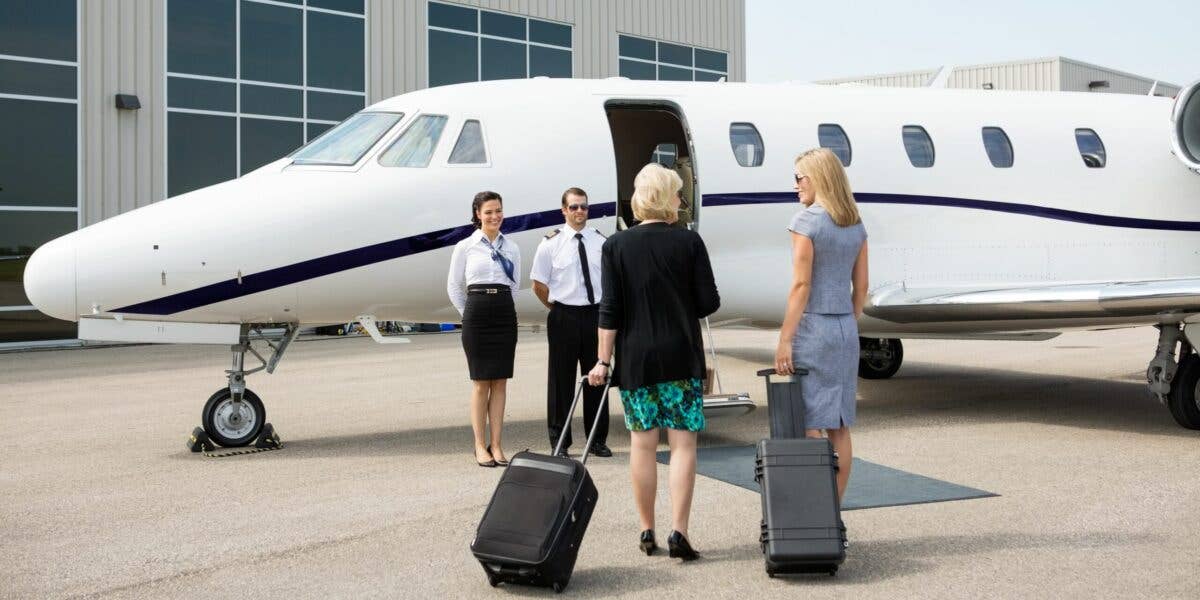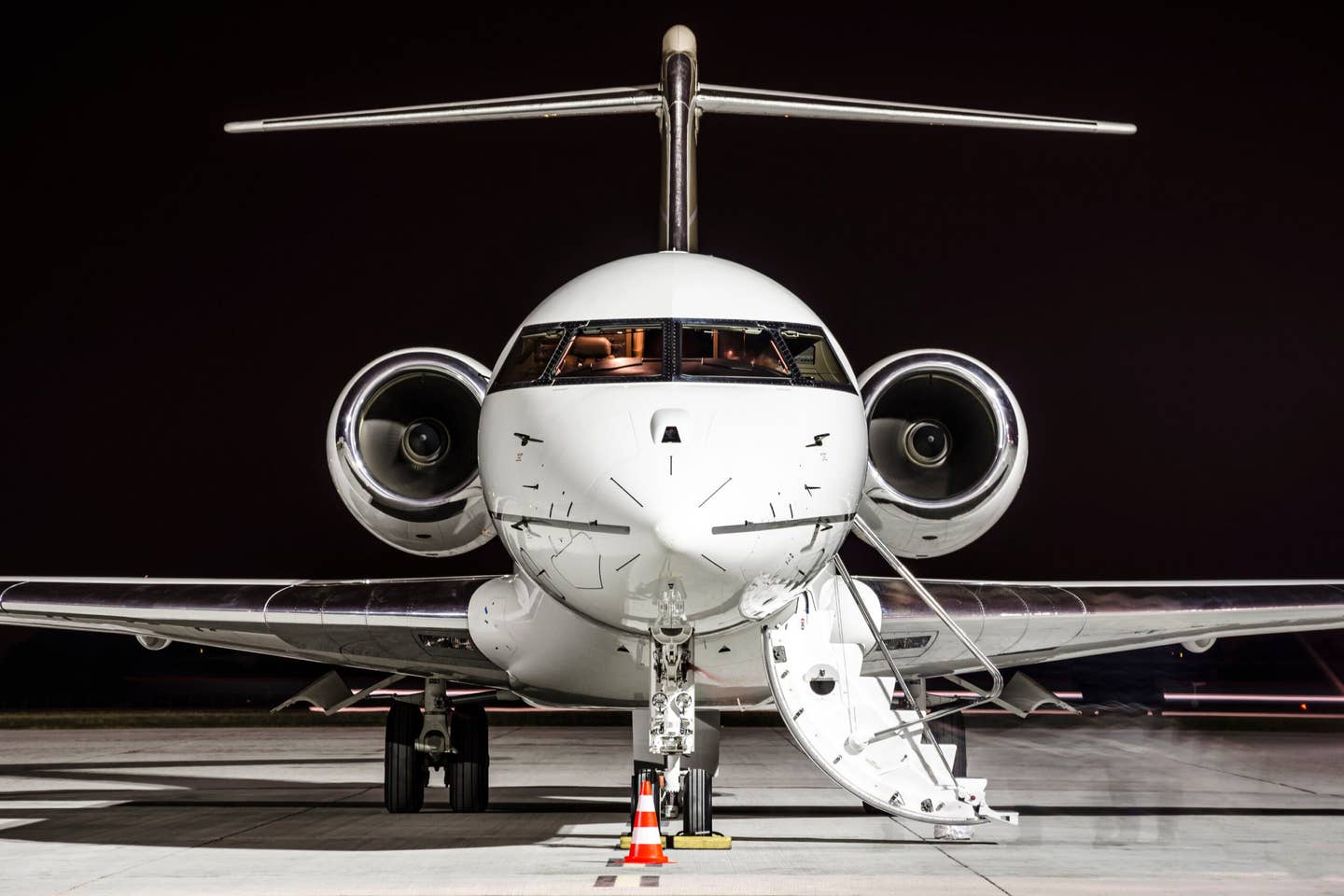
Learn more about how private jet charter flights compare to other forms of travel. [Credit: CanvaPro]
Billionaire bankers, pop stars…international spy? This is probably who you picture walking down the steps of their own private jet. Who can blame you? The convenience, comfort, and privacy make flying private perfect for these demographics.
But in the last few years—especially following the pandemic—this life of luxury has become more accessible than ever through the growing popularity of charter services. In this article, we’ll discuss what a charter flight is, some of the (less obvious) benefits, and how to charter a private jet.
What Is a Charter Flight?
Here’s a dirty little secret: That celebrity you follow who always posts pictures of trips on a private jet likely doesn’t own it (we’re not talking about Taylor Swift here, folks). Given that the cost of a new private jet can easily reach $70 million, plus hundreds of thousands of dollars in annual operating costs, owning a private jet is out of reach for even the average celebrity. Even at the higher end of wealth, many people opt for fractional ownership (think timeshare for planes) through companies like Magellan Jets or Villiers Jets.
The far more common, cost-effective, and accessible path to flying private, however, is chartering a plane. Chartering a plane is distinct from flying commercial in that, when you charter a plane, you are effectively renting the entire plane. Essentially, you tell the charter company what kind of plane you want, where you want to go, and when you want to go. It does the rest.
There are a number of benefits to chartering planes. For example, it enables you to:
- Avoid regular airport terminals and security, saving time and a lot of headache.
- Fly to smaller, more convenient airports, potentially allowing you to visit multiple. locations (i.e. that factory or satellite office) in less time.
- Not be subject to the airlines’ schedules, providing more flexibility.
- Stay away from other passengers.
To be clear, flying commercial—even first class—will almost certainly be cheaper. But if you value your time, convenience, and flexibility, the benefits of chartering your own private jet may be worth it. Luckily, thanks to increased demand and competition, booking a private jet has never been easier.
5 Steps to Book a Private Jet Air Charter Service
From finding a plane to charter to receiving a private jet quote, charter companies have stepped up their game in recent years to make this option extremely accessible. Here are the steps you should follow to charter a private jet.
Step 1: Identify Your Executive Jet Charter Needs
If you need to fly from Los Angeles to New York City on a Monday morning and return Tuesday afternoon, you can likely find a first-class ticket on an airline that provides the convenience and comfort you desire. However, if you need to fly from Midland, Texas, to Des Moines, Iowa, for a business meeting at 8 a.m. then drop off your dog in Billings, Montana, by noon before a 4 p.m. meeting in San Diego on a Wednesday, a commercial airliner probably isn’t going to work.
That’s where the flexibility of a charter jet can be beneficial. Most people don’t realize that in addition to the major international airports in large cities, there are hundreds of regional airports that airlines service less frequently, if at all. Private jets, on the other hand, can access these locations easily, providing greater convenience to passengers.
If you crave such convenience, then start thinking about your budget. We’ll break down private jet quotes in another step, but generally speaking, the bigger the jet, the bigger the bill. Size depends on two variables: the number of passengers and distance to travel. Private and business jets can carry anywhere from four to 19 passengers, plus crew. However, even if you are the sole passenger, small jets simply cannot carry enough fuel to fly long range. You’ll need to pay for a larger jet with greater range if you are expecting to travel from, say, New York to Milan.
Based on your destination and passenger requirements, charter jet companies like Magellan Jets and Trilogy Aviation Group will determine the type of plane you need.
Step 2: Research Private Jet Charter Airlines
Next you’ll want to do a little research. Unlike the extremely regulated airlines, charter companies vary in quality. The FAA’s Safe Air Charter initiative encourages customers to be weary of deals that seem too good to be true. While competition may drive down prices slightly, licensing, maintenance, and jet fuel aren’t cheap.
No detail is overlooked, guaranteeing an exceptional and seamless experience. Our Private Aviation Advisors collaborate with the industry's most experienced and talented crews to ensure you find the perfect private jet charter flight. Book On-Demand Private Jet Charters and Fly With Flexibility!
Request a QuoteWell-known companies like Trilogy Aviation and Villiers Jets have excellent safety and service records. Deciding between similarly reputable companies might come down to availability based on the size of their fleet and the type of jets offered. Some companies specialize in light jets, such as the Cessna Citation CJ3, while others may focus their businesses on longer range jets, such as the Global 6000 or Gulfstream G550.
These considerations can seem dizzying to the average customer. That’s where a private jet broker can come in. Brokers are like realtors for planes. They match customers to charter companies based on all of the requirements discussed above, hunt for deals, and charge a commission for their service. You can also check out our guide to the best charter jet services for recommendations.
Step 3: Get Private Jet Quotes and Compare Options
Obtaining a private jet quote has never been easier online. For example, Trilogy Aviation Group empowers you to obtain a quote with just your origin and destination, travel dates, and number of passengers—it’s like Google Flights for chartering a private jet.
Keep in mind these are estimates, and the cost will be affected by a number of factors, including the:
- Type of plane
- Distance to travel
- Airport fees (i.e. landing fees)
- Jet fuel surcharges, which are the primary variable costs
Additionally, insurance, cost of regulatory compliance, maintenance, and flight crew are rolled into these prices. Regardless, expect to receive quotes for hourly rates (i.e. $4,000 per hour). In rare cases you may see “all-in” fees, but these are typically only offered for empty legs.
While these fees quickly add up, keep in mind you are flying private, and chartering is usually far more cost-effective than owning your own jet. Still, with so many charter companies competing, don’t be afraid to compare quotes and negotiate certain fees.
Step 4: Book Your Charter Flight
Once you’ve decided on a private jet operator or broker, booking is fairly straightforward. You’ll receive a service contract, which you should read carefully, sign, and remit with payment. Some companies accept credit cards, while others require wire transfers (after all, we are talking tens of thousands of dollars, in most cases). Additional fees, such as limousine services coordinated by the charter company for instance, will be calculated and added to the final bill.
While flying private offers some level of anonymity, you’ll still need to provide proof of identification and, for international flights, passports and visas (if applicable) for all passengers. Don’t be surprised if the pilots also ask about things like food or plants in your luggage, as you are required to report such items to customs.
Step 5: Prepare for Your Flight
There are a few things to know before you go.
First of all, say goodbye to busy airport terminals. Private jets operate out of FBOs. These are usually located on the opposite end of the airport from commercial terminals, and provide all of the comfort and convenience you would expect when paying for a private jet. In most cases, you can show up just minutes before your flight, check in with the FBO desk, and have a seat in the lounge.
The FBO will notify your pilots of your arrival, and you’ll be escorted to your plane. If you opt for limousine service booked through the operator, you may skip the FBO altogether and instead be driven directly to your plane.
That’s right: no TSA, no luggage check. The pilots are obligated to ensure none of the baggage poses a safety to flight, but unless you’re traveling internationally, don’t expect to go through metal detectors or remove your shoes. Just hand your bags to the flight crew and settle in for a quick preflight briefing, and you’ll be taxiing within minutes.
Depending on the size of the plane, you can expect first-class service from the flight crew, including meals if available. Many operators will allow pets and even your own beverages. Watch movies, prop your feet up, and relax. Do as you please, so long as you don’t cause a safety concern for the flight crew.
So, Now You Know How to Charter a Private Jet…
Expensive? Relative to commercial flying, yes. Convenient and comfortable? Absolutely. If you value your schedule, flexibility, and privacy, chartering a plane can be worth the cost and has never been more accessible. Make sure to read this article if you want to learn even more about how they compare.
Still, do your research and ensure the operator is safe and reputable. And most of all, enjoy it! Flying in a private jet is true luxury.
FAQ
How much does it cost to charter a private jet?
Costs vary greatly based on the size of the jet, which is primarily determined by the number of passengers and the distance to be flown. Short domestic flights for 5-9 passengers may average about $2,000 per hour, while international flights may start around $10,000 per hour. Check out this private jet charter cost estimator for more information.
Is it worth it to charter a private jet?
If you require flexibility in location and schedule, chartering a private jet may be the perfect option for visiting multiple rural sites in a single day. Private charters have access to airfields that airlines don’t and can offer massive time savings by bypassing TSA and airline delays.
Is it better to own or charter a jet?
Unless you fly more than 300 hours a year, chartering is likely more cost effective than owning. Chartering also provides more flexibility in the types of planes on which you fly and allows you to hunt for deals across charter companies. See this analysis of owning vs. chartering a private plane for a more detailed breakdown.

Sign-up for newsletters & special offers!
Get the latest FLYING stories & special offers delivered directly to your inbox







